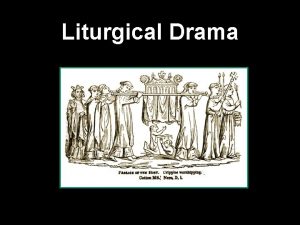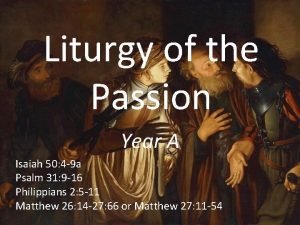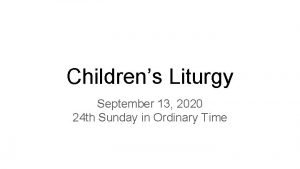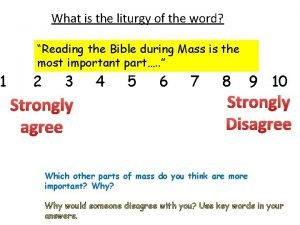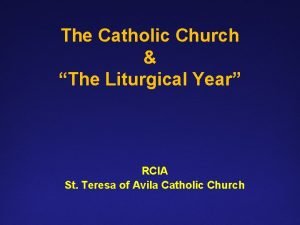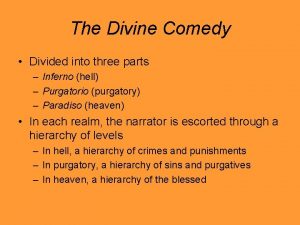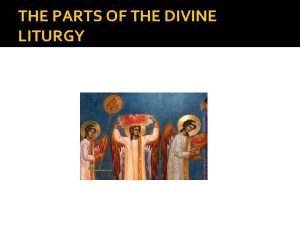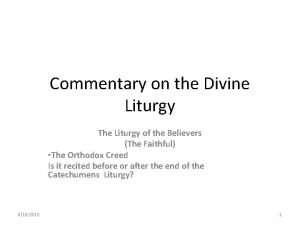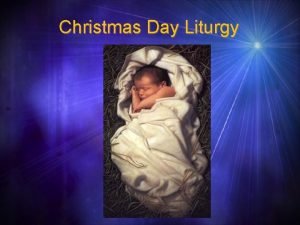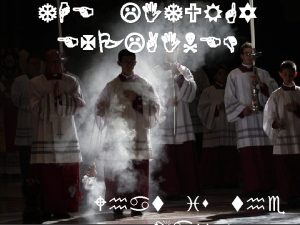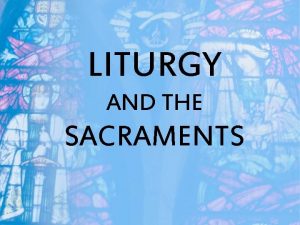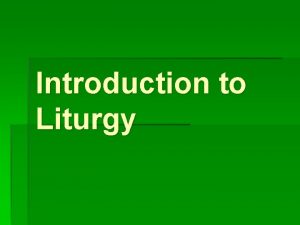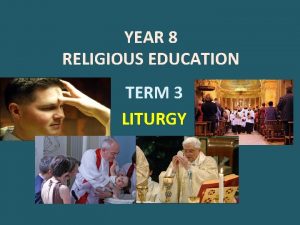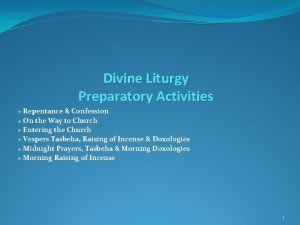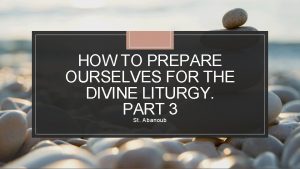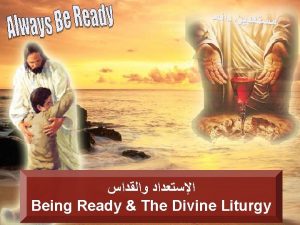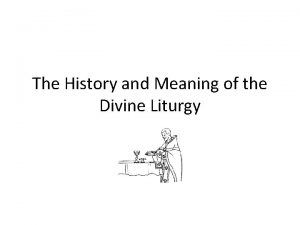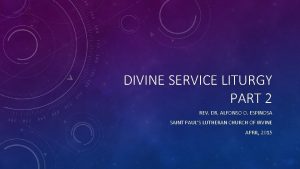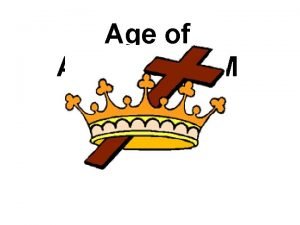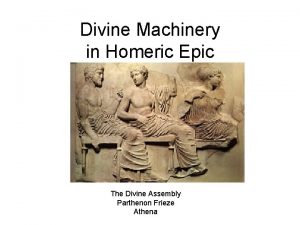THE PARTS OF THE DIVINE LITURGY LITURGY CORPOTATE






















- Slides: 22

THE PARTS OF THE DIVINE LITURGY

LITURGY – CORPOTATE DRAMATIC ACTION � The Divine Liturgy is divided into several parts. � Each part corresponds to a particular event of our Lord’s Life, thus giving to the Divine Liturgy the form of a corporate dramatic action, by which the whole Life of Christ is reenacted

OFFERTORY SERVICE � The priest and the worshippers have their distinct roles for the proper representation of the Divine Drama � Before every Divine Liturgy the Offertory is made in which the priest in the Sanctuary prepares the Elements of the Sacrament for consecration

OFFERTORY SERVICE � This part of the Liturgy commemorates Christ’s early Life, which was a preparation for His public ministry � The offertory service is performed during the Matins service without being seen by the congregation, just as Christ’s early Life was not shown to the world as being the revelation of God’s life

LITURGY PROPER � The liturgy proper is divided into two parts: i. The preparation ii. The Sacramental part

The Preparation � It ends after the Creed � This part corresponds to our Lord’s Life during His public ministry � It is a representation of the most important events of His Life; namely,

THE PREPARATION His coming to the world (the Introit of the Gospel) � His teaching (reading from the Epistles and the Gospel) � His death and burial (the Great Introit) �

THE PREPARATION � His Resurrection (indicated by the shaking of the “Aer” over the Holy Gifts during the recitation of the Creed by phrase “and rose on the third day”) � His Ascension to Heaven (indicated by the phrase “and ascended into Heaven”)

The Sacramental part � It begins with the exhortation of the deacon or the priest: “Let us stand well; let us stand with fear” � This part of the Divine Liturgy is the most sacred, because in it the Sacrament of the Holy Eucharist is consummated

THE DIVINE LITURGY – A SINGLE ACT OF WORSHIP � These two parts of the Divine Liturgy are so closely connected with each other that they form but one single act of worship � For this reason, Orthodox Christians must attend the entire Divine Liturgy � And this they do, not as a duty, but as a distinct privilege

THE CONGREGATION � They may feel unworthy to attend it, and yet they know that they are welcome by our Lord, Who numbers them among His chosen people

THE SIGN OF THE CROSS � The sign of the Cross has been used by the Christians since the time of the Apostles � We are led to this service of God by means of the sign of the Cross, because it reminds us of Christ’s death on the Cross, to which “God gave His only begotten Son” out of His love to the world

THE SIGN OF THE CROSS � The sign of the Cross on our bodies is also a prayer for God’s blessing upon ourselves and others � It has often proved a protection against evil, whether in ones inner thoughts or outward actions, when made in true faith in its power

THE SIGNOF THE CROSS � Therefore, we rightly make it when we start and close our prayers � When we enter a Church � When we kiss the icons of the Saints � When the name of the Persons of the Holy Trinity, the name of the Virgin Mary and of the Saints are pronounced during the services

THE SIGNOF THE CROSS � When sacred instances occur during the Divine Liturgy � When we start and finish our meals � And on many other occasions � Its frequent repetition, when we are mindful of its significance can become to us a source and fountain of every blessing


READING COMPREHENSION 1. Why is the offertory service performed without 2. 3. 4. 5. 6. being seen by the congregation? What does the Preparation correspond to? What does the great introit represent? Which part of Jesus’ life is reenacted during the shaking of the aer? Why is the sacramental part of the Liturgy the most sacred? What is the significance of the sign of the Cross?


VOCABULARY EXERCISE II � 1. 2. 3. 4. 5. 6. 7. 8. 9. 10. 11. 12. 13. 14. Find words in the text with the following meaning: United or combined into one To repeat the actions of a past event Clear Fit, suitable Honour, keep alive the memory Making known of something hidden Earnest request Right, benefit Not deserving Born Careful Source, spring Crush Give as an offering 1. Corporate 2. Reeanct 3. Distinct 4. Proper 5. Commemorate 6. Revelation 7. Exhortation 8. Privilege 9. Unworthy 10. Begotten 11. Mindful 12. Fountain 13. Trample down 14. bestow

VOCABULARY � Correspond: (v) to be in agreement or conformity, to be similar, to go with, to equal, αντιστοιχώ, συμπίπτω, ταιριάζω, ανταποκρίνομαι, είμαι ανάλογος � Corporate: (adj. ) of or being or belonging to a corporation or group, united or combined into one, εταιρικός, συλλογικός � Reenact: (v) to repeat the actions of a past event, αναπαριστώ � Distinct: (adj. ) clear, σαφής, ευδιάκριτος � Proper: (adj. ) fit, suitable, κατάλληλος, ορθός, σωστός � Commemorate: (v) honour, keep alive the memory of sb dead, μνημονεύω

VOCABULARY � � � Revelation: (n) revealing, making known of something secret or hidden, αποκάλυψη Revelation, the: (n) the last book of the New Testament, Apocalypse, Αποκάλυψη Creed, the: (n) system of beliefs or opinions, esp, on religious doctrine, the Creed: the Symbol of faith, short summary of Christian doctrine, το Σύμβολο της Πίστεως, το Πιστεύω (προσευχή) Introit: (n) a psalm or antiphon sung or said while a priest approaches the altar for Eucharist, small introit and great introit, μικρή είσοδος και μεγάλη είσοδος. Ascension: (n) when Jesus left the earth and went into heaven, Ανάληψη Resurrection: (n) the rising of Jesus from the tomb, Ανάσταση

VOCABULARY � Exhortation: (n) earnest request, speech that exhorts sb: παρότρυνση, προτροπή � Privilege: (n) right, benefit enjoyed only by a person or group of people, προνόμιο � Unworthy: (adj. ) not deserving, ανάξιος, ευτελής � Begotten: (adj. ) born, γεννημένος � Pronounce: (v) utter, verbalize, προφέρω � Mindful: (adj. ) attentive, aware of or careful of, επιμελής, προσεκτικός � Significance: (n) importance, σημασία � Fountain: (n) source, spring, πηγή � Trample down: (v) crush , tread roughy, ποδοπατώ � Bestow: (v) give as an offering: δίδω, παραχωρώ �
 Four parts of liturgy
Four parts of liturgy Liturgical drama
Liturgical drama Swanson
Swanson Catholic children's liturgy worksheets
Catholic children's liturgy worksheets Ritual of the secular franciscan order
Ritual of the secular franciscan order Liturgy of.the word
Liturgy of.the word 6 days of holy obligation
6 days of holy obligation The divine comedy summary
The divine comedy summary Diễn thế sinh thái là
Diễn thế sinh thái là Lp html
Lp html V cc
V cc Vẽ hình chiếu vuông góc của vật thể sau
Vẽ hình chiếu vuông góc của vật thể sau 101012 bằng
101012 bằng Khi nào hổ con có thể sống độc lập
Khi nào hổ con có thể sống độc lập Lời thề hippocrates
Lời thề hippocrates Glasgow thang điểm
Glasgow thang điểm đại từ thay thế
đại từ thay thế Quá trình desamine hóa có thể tạo ra
Quá trình desamine hóa có thể tạo ra Công của trọng lực
Công của trọng lực Thế nào là mạng điện lắp đặt kiểu nổi
Thế nào là mạng điện lắp đặt kiểu nổi Các loại đột biến cấu trúc nhiễm sắc thể
Các loại đột biến cấu trúc nhiễm sắc thể Biện pháp chống mỏi cơ
Biện pháp chống mỏi cơ Bổ thể
Bổ thể

